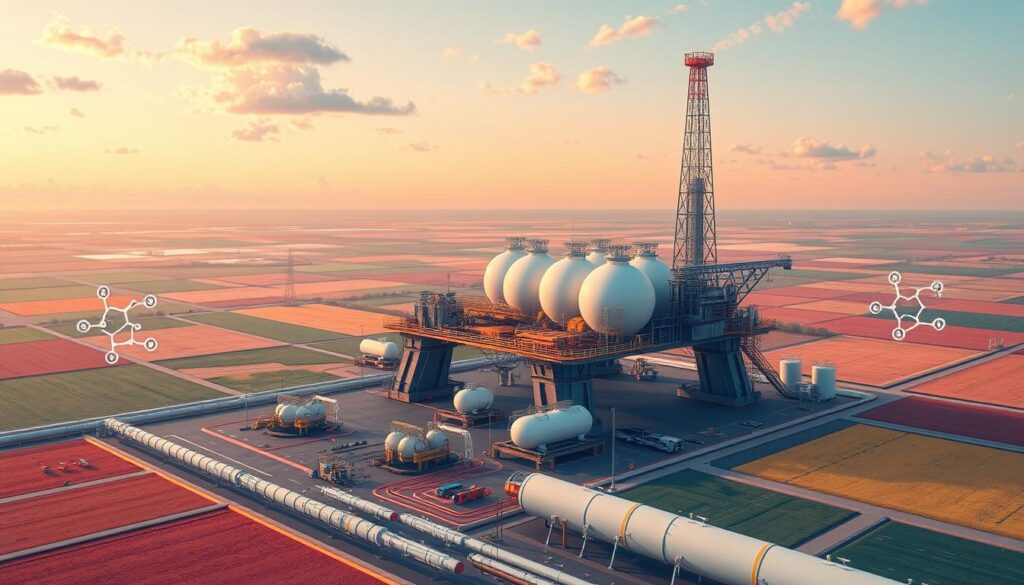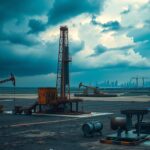Inert gases are key in keeping petroleum engineering safe and efficient. They are used to make closed systems safe from fires. Knowing about these gases helps improve safety in the oil industry.
Petroleum work often deals with dangerous substances. Inert gas tech helps by removing oxygen and stopping fires. These systems are vital for safe work in the industry.
Nitrogen and other gases make work areas safe in many oil jobs. They keep tanks and big facilities safe from big problems. This makes work safer and more stable.
Key Takeaways
- Inert gases eliminate oxygen to prevent combustion in petroleum environments
- Continuous oxygen monitoring is critical for safety
- Nitrogen is the most common inert gas in petroleum engineering
- Inerting systems reduce potential fire and explosion risks
- These technologies improve overall operational efficiency
What is Inert Gas Petroleum Engineering
Inert gas petroleum engineering is key in oil and gas. It uses non-reactive gases to keep things safe and efficient. As a petroleum engineer, you’ll work with these gases to prevent dangers in industrial processes.
Inert gases make things safe by stopping fires and lowering risks. They are picked for their special chemical traits. These traits make them safe to use with other materials.
Basic Principles of Inertness
In petroleum engineering, inertness means no fire can start. Inert gases have less than 8% oxygen, which is too little for fire. The aim is to keep gas levels around 10% to stop fires.
Chemical Properties of Inert Gases
Inert gases are made up of specific chemicals. Nitrogen, argon, and carbon dioxide are often used. Each gas is chosen for its unique qualities, like stopping explosions in tanks or cleaning pipes.
Role in Oil and Gas Operations
As a petro engineer, you’ll use inert gases in many important ways. They keep ships safe and stop fires caused by static electricity. For example, inerting systems keep tank spaces safe during oil transport, cutting down explosion risks.
Safety is top priority in petroleum engineering. Inert gases are a big part of keeping things safe. By knowing how to use inert gases right, you can lower risks in tough industrial settings.
Types of Inert Gases Used in Petroleum Industry
In the petroleum industry, picking the right inert gas is key for safety and work efficiency. Nitrogen and carbon dioxide are the top choices, each with special qualities for important tasks.
Nitrogen is the top pick for inert gas jobs because it’s common and doesn’t react much. Since air is mostly nitrogen, it’s great for keeping tanks safe from explosions. It also helps keep oxygen levels low in oil ships, cutting down fire risks a lot.
Carbon dioxide is also vital in oil work. Its heavy nature helps push out oxygen in tight spots. Special machines can make clean carbon dioxide, keeping fires away.
| Inert Gas | Primary Applications | Key Characteristics |
|---|---|---|
| Nitrogen | Tank inerting, pipeline maintenance | Low cost, widely available |
| Carbon Dioxide | Fire suppression, confined space management | High density, effective oxygen displacement |
| Argon | Welding processes, specialized industrial applications | Excellent shielding properties |
| Helium | Leak detection, diving operations | Low molecular weight, high thermal conductivity |
Argon and helium have special jobs in oil work. Argon is great for welding, mixed with 10% carbon dioxide. Helium is used in diving and some industrial tasks because of its special qualities.
Knowing what each inert gas does helps oil workers make smart choices about safety, work, and needs.
Safety Applications in Oil and Gas Operations
Safety is key in petroleum engineering. Inert gases help keep people and places safe from dangers. They make sure areas are safe during tough work.
Explosion Prevention Strategies
Keeping explosions away is very important in reservoir engineering. Inert gases lower oxygen levels to stop fires. Gases like nitrogen, argon, and carbon dioxide are used to keep areas safe.
Tank Cleaning Procedures
Cleaning tanks needs careful safety steps. Inert gases remove explosive air, making it safe to work. They keep oxygen levels right and stop harmful chemical reactions.
Pipeline Maintenance Safety
Keeping pipelines safe is crucial. Inert gases help by pushing out air during checks. They also seal leaks and protect against corrosion and big failures.
| Inert Gas Type | Primary Safety Application | Oxygen Reduction Capability |
|---|---|---|
| Nitrogen | Tank Blanketing | Below 8% Concentration |
| Carbon Dioxide | Pipeline Purging | Below Limiting Oxygen Concentration |
| Argon | Equipment Protection | Complete Oxygen Displacement |
Using these safety methods, engineers can lower risks at work. They also protect important things from big problems.
Inerting Methods and Techniques
In petroleum engineering, inerting is key to stop explosive atmospheres. It keeps operations safe. You’ll learn about important ways to handle dangerous areas with gas.
Dilution purging is a main method. It uses inert gas to replace old air in tanks and pipes. This lowers oxygen levels, making places safer from explosions.
Pressure swing purging is another advanced method. It uses cycles of pressurization and depressurization to clear out harmful gases. Nitrogen is often used because it protects against oxidation and chemical reactions.
Choosing the right inerting plan boosts safety in many areas. It helps with storage, processing, and moving goods. Using the right techniques keeps everything safe from dangers.
| Inerting Method | Primary Application | Key Benefit |
|---|---|---|
| Dilution Purging | Storage Tanks | Continuous Gas Replacement |
| Pressure Swing Purging | Pipeline Systems | Comprehensive Gas Removal |
| Blanketing | Processing Equipment | Oxygen Concentration Reduction |
Knowing these methods helps engineers make safer work places. By controlling gas, they stop explosions, protect gear, and keep work areas good.
Production and Generation of Inert Gases
It’s key to know how inert gases are made for the oil industry. These gases help keep things safe and running smoothly. Making them right needs special skills.
On-site Generation Systems
Nitrogen is a main inert gas in oil work. It’s made right at places using new tech. Air separation units and membrane tech help make pure nitrogen.
These systems pull nitrogen from the air. They give a steady and cheap supply of gas for important tasks.
Industrial Supply Methods
Carbon dioxide is another key inert gas in oil work. Unlike nitrogen, CO2 comes in liquid form. It’s sent through special networks to places that need it.
Compressed gas tanks and big liquid storage help get the gas to where it’s needed.
Quality Control Measures
Keeping inert gases pure is very important. There are strict checks to make sure. These include exact measurements and tests.
They make sure the gas is mostly pure. This means it works well and safely in tough places.
| Inert Gas | Generation Method | Typical Purity |
|---|---|---|
| Nitrogen | Air Separation Units | 99.5% |
| Carbon Dioxide | Industrial Supply | 99.9% |
Corrosion Prevention Using Inert Gases
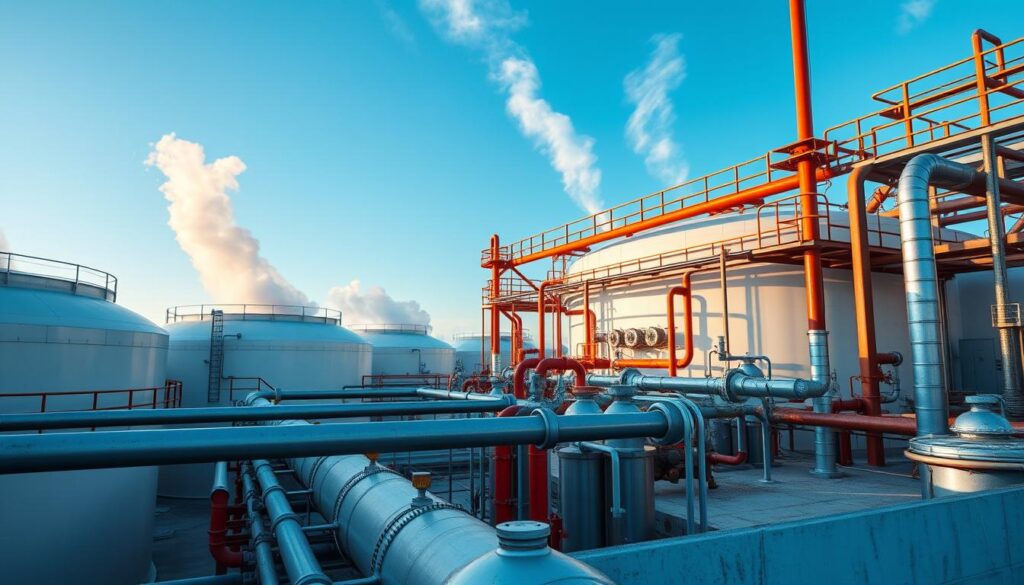
In petroleum engineering, corrosion is a big problem. It can damage infrastructure and cost a lot of money. Inert gases are a key solution to protect important assets from damage.
Petro engineers use special methods to stop corrosion. They use gases like nitrogen to keep oxygen out. This helps keep pipelines and tanks safe.
| Inert Gas Type | Corrosion Prevention Effectiveness | Oxygen Reduction Level |
|---|---|---|
| Nitrogen | High | < 5% |
| Carbon Dioxide | Moderate | < 8% |
| Argon | Moderate | < 10% |
Keeping oxygen levels under 8% helps a lot. Using inert gases helps equipment last longer and saves money on repairs.
It’s important to watch the oxygen levels closely. If oxygen gets too high, it can damage metal in oil and gas systems.
Environmental Impact and Regulations
The petroleum industry is under more scrutiny for its environmental practices. It’s important to understand the complex rules for sustainable operations and managing resources well.
Emission Control Standards
Petroleum engineering must follow strict rules on emissions. Data shows natural gas is a big part of global power. The World Energy Agency says managing carbon dioxide emissions is key.
| Emission Type | Emission Rate (kg per million Btu) |
|---|---|
| Natural Gas | 53.97 |
| Coal | 95.35 |
| Petroleum Coke | 102.1 |
Regulatory Compliance
Following international standards is crucial. The revised Regulation 62 sets rules for inert gas systems. It requires keeping oxygen levels below 8% in cargo tanks and maintaining positive pressure at sea.
Sustainable Practices
Sustainable reservoir engineering needs new ways to reduce environmental harm. This includes cutting greenhouse gas emissions and using advanced monitoring. It also means better management of inert gases.
By adopting these methods, your petroleum operations can be more eco-friendly. This way, you can keep doing great work while caring for the planet.
Equipment and Infrastructure Requirements
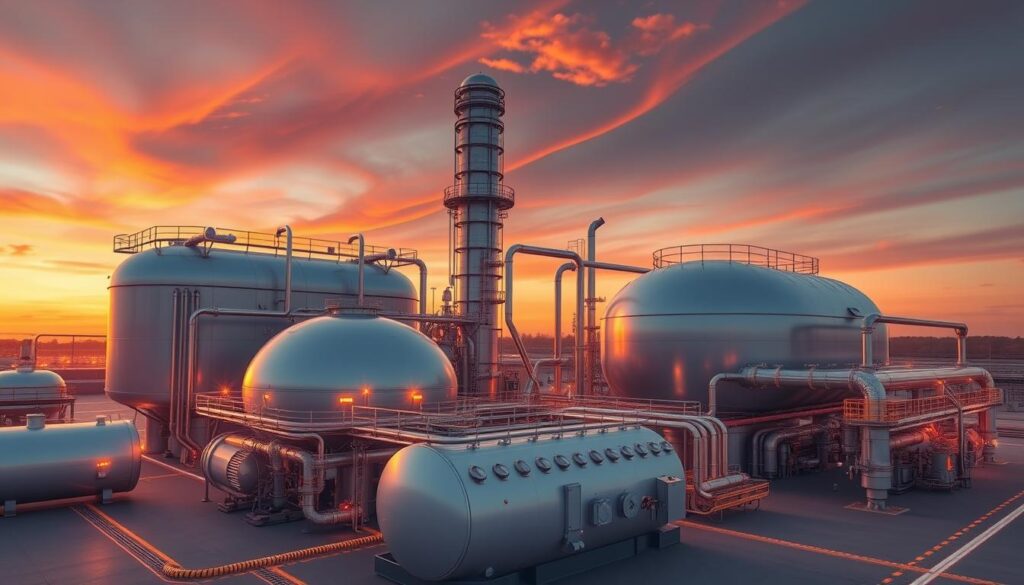
Choosing the right equipment for inert gas systems is key in petroleum engineering. It ensures safety and efficiency. Your setup needs special parts for handling gas in oil and gas work.
Petroleum engineers use important equipment for inert gas systems. Measurement and metering stations are vital. They control gas flow and monitor it closely.
These stations track gas volumes, pressure, and type accurately.
Special parts are needed for the job. These include:
- Inert gas sluices for controlled atmospheres
- Advanced nozzles for liquid nitrogen
- Blanketing systems for tanks
It’s important for engineers to know the dangers of compressed gases. These gases can be toxic, flammable, or cause asphyxiation. Your gear must protect against these risks.
| Equipment Type | Primary Function | Safety Considerations |
|---|---|---|
| Metering Stations | Gas Flow Control | Pressure Monitoring |
| Inert Gas Sluices | Atmosphere Management | Contamination Prevention |
| Liquid Nitrogen Nozzles | Precise Gas Injection | Temperature Regulation |
| Tank Blanketing Systems | Storage Protection | Explosion Prevention |
Safety is always first in petroleum engineering. Your setup needs strong monitoring for gas risks. Good safety plans stop accidents and keep things running smoothly.
Choosing the right gear is important. Think about how you handle cylinders, store them, and manage pressure. Engineers must make sure gas cylinders are safe and stored right.
Cost Analysis and Economic Benefits
Understanding the economic side of inert gas technologies is key for petroleum engineers. These systems offer more than just upfront costs. They bring strategic benefits in efficiency and cost control over time.
Investment Considerations
Looking at inert gas systems in the oil industry, your investment plan must consider many things. Costs include buying equipment, setting it up, and linking it to current systems. Studies by the EPA show that these costs can be made up for by big savings and better safety.
Operational Cost Savings
Experts in petroleum engineering see big savings with inert gas tech. By using these systems wisely, you can cut costs by 40-70% in certain areas.
ROI Calculations
| Investment Parameter | Potential Savings | Impact Range |
|---|---|---|
| Capital Cost Reduction | 18-40% | Medium to High |
| Operating Cost Savings | 71.8% | Significant |
| Net Profit Improvement | 8% | Moderate |
To figure out return on investment, you need to look at all the details. Petroleum engineering professionals should think about less downtime, better safety, and longer system life. These are key to seeing the economic gains.
Investing in inert gas tech can change how you do business. It brings clear financial benefits across the oil industry.
Best Practices for Handling Inert Gases
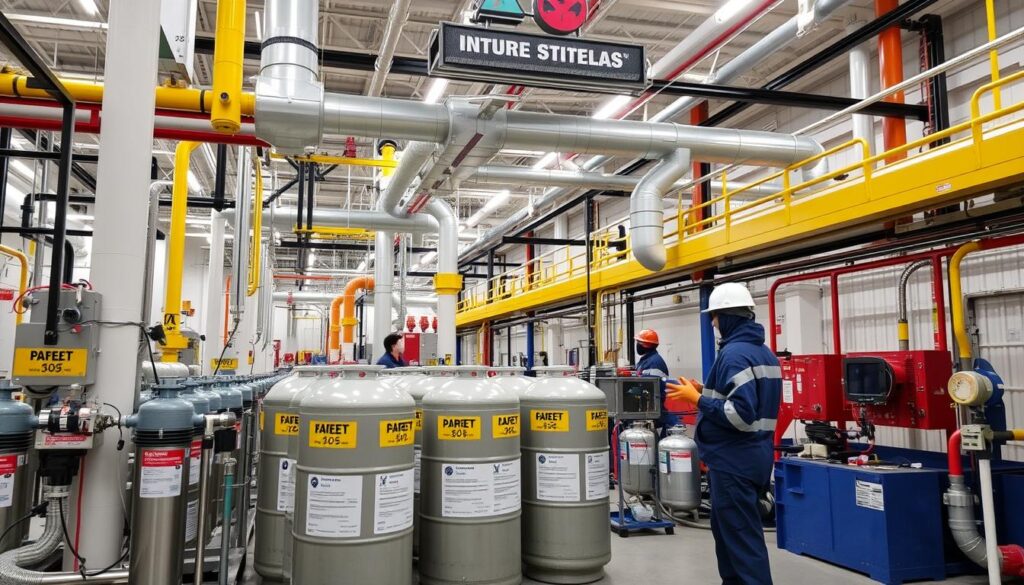
In the world of petroleum engineering, handling inert gases is very important. It needs careful safety and precision. If not done right, it can cause big problems.
In November 2012, five officers on an LPG tanker died. This was because of wrong handling of inert gas systems.
Safety starts with knowing the gas. The oxygen level must always be 21%. If it’s not, it can harm your brain or even kill you.
When working with inert gases, watch the oxygen levels closely. Also, follow strict safety rules.
Here are some key best practices for petroleum engineers:
- Use 99% nitrogen or argon for the best inert gas use
- Keep gas flow rates low (about 1 liter per minute)
- Do proper gas freeing processes
- Make sure flue gas readings are under 1% of the lower flammable limit
Important safety tips include avoiding electrostatic risks and toxic gas formation. Hydrogen sulfide is very toxic and can form during work, especially with sour crude oil. Always clear gas before maintenance and wear the right protective gear.
For petroleum engineers, handling inert gases is a critical job. By sticking to safety rules, checking gas levels, and using pure inert gases, you can lower risks at work.
Monitoring and Control Systems
In petroleum engineering, advanced monitoring and control systems are key. They help manage inert gas applications safely and precisely. Your petro engineer team uses top software to keep operations running smoothly.
Modern systems use special sensors and analyzers to watch oxygen levels. They stop combustion risks by keeping oxygen low. Usually, they keep oxygen below 8% to keep places safe.
Important tools include advanced software like Process Application Management (PAM) and sensor networks. These systems track data in real-time. They help petroleum engineers:
- Watch oxygen levels
- Spot safety risks
- Control processes automatically
- Follow rules
The success of these systems relies on accurate sensors. Dew-point sensors and zirconia oxygen analyzers check nitrogen and keep safety high. For example, the Senz-TX Zirconia Sensor gives exact oxygen readings during important work.
With strong monitoring and control systems, petroleum engineering teams cut down risks. They also boost safety and use resources better. Investing in these technologies means safer workplaces and better work flow.
Conclusion
Inert gas petroleum engineering is key to keeping industries safe. Knowing about these systems helps make work safer and more efficient. They stop flammable gas fires and keep oxygen levels just right.
Nitrogen and membrane inert gas systems help control complex work areas. They keep oxygen in tanks below 8%, cutting down on dangers. Knowing rules like SOLAS and standards from Lloyd’s Register shows how important these systems are.
Keep learning about inert gas petroleum engineering. Always check things, follow safety rules, and watch for new tech. Your work helps make the petroleum industry safer and more efficient.
Research and new tech will keep improving inert gas systems. Stay up to date and use the latest in petroleum engineering. This will help solve big industrial problems.
